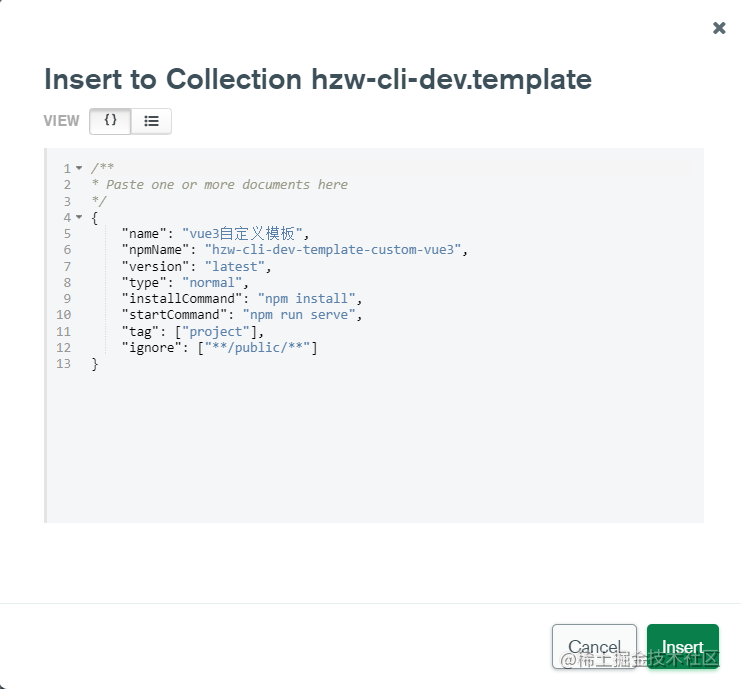自定义项目模板开发
在 hzw-cli-dev-template 这个模块下,新建模板 hzw-cli-dev-template-custom-vue3。
修改 package.json , 添加 main 字段
"main": "index.js"
添加 index.js
function install(options) {
console.log(options);
}
module.exports = install
发布到 npm
数据库添加一条新的数据

自定义模板安装逻辑开发
commands\init\lib\index.jsinstallCustomTemplate
/**
* @description: 安装自定义模板
* @param {*}
* @return {*}
*/
async installCustomTemplate() {
// 查询自定义模板的入口文件
if (await this.templateNpm.exists()) {
const rootFile = this.templateNpm.getRootFilePath();
if (fs.existsSync(rootFile)) {
//开始执行自定义模板
const templatePath = path.resolve(this.templateNpm.cacheFilePath, 'template')
const options = {
templateInfo: this.templateInfo,
projectInfo: this.projectInfo,
targetPath: process.cwd(),
sourcePath: templatePath
}
const code = `require("${rootFile}")(${JSON.stringify(options)})`
await execAsync('node', ['-e', code], { stdio: 'inherit', cwd: process.cwd() })
// 自定义模板安装成功
}
}
}
hzw-cli-dev-template-custom-vue3\index.js
const fse = require("fse")
const inquirer = require('inquirer')
const glob = require('glob')
const ejs = require('ejs')
/**
* @description: ejs 模板渲染
* @param {*}
* @return {*}
*/
async function ejsRender(options) {
return new Promise((resolve, reject) => {
// 遍历文件列表
glob("**", {
cwd: options.targetPath,
nodir: true,
ignore: options.ignore || []
}, (err, files) => {
if (err) {
reject(err)
}
// 对文件列表使用 ejs 进行渲染
Promise.all(files.map((file) => {
const filePath = path.join(process.cwd(), file)
return new Promise((resolve1, reject1) => {
ejs.renderFile(filePath, options, {}, (err, res) => {
if (err) {
reject1(err)
}
// 将源文件替换成 ejs 渲染后的文件
fse.writeFileSync(filePath, res)
resolve1(res)
})
})
}))
.then(() => resolve(files))
.catch((err) => reject(err))
})
})
}
async function install(options) {
const promptArr = []
const descriptPrompt = {
type: 'input',
message: '请输入组件描述',
name: 'description',
validate: (a) => {
if (a) {
return true;
}
return '组件描述不可以为空';
},
}
promptArr.push(descriptPrompt)
const answer = await inquirer.prompt(promptArr);
options.description = answer.description
// 获取模板缓存路径
// 获取模板所在目录 获取当前目录
const { sourcePath, targetPath } = options
try {
// 确保目录存在 不存在会创建
fse.ensureDirSync(sourcePath);
fse.ensureDirSync(targetPath);
// 拷贝模板到当前目录
fse.copySync(templatePath, targetPath)
// ejs 模板渲染
options.ignore = ['node_modules/**', ...options.templateInfo.ignore]
// const ops = { ignore }
await ejsRender(options)
// const { installCommand, startCommand } = this.templateInfo
// 依赖安装
// await this.execCommand(installCommand, '依赖安装成功')
// 启动命令
// await this.execCommand(startCommand, '项目启动成功')
} catch (error) {
log.error(error.message)
} finally {
spinner.stop(true)
log.warn('模板安装成功')
}
}
module.exports = install
第一阶段总结
本课程的第一阶段任务到此就结束了。主要内容就是开发脚手架的创建项目功能,脚手架还有其它功能,会在后面的课程中继续补充。
由于自身能力问题,第一阶段的课程加餐,也就是 nodejs 相关的源码分析,都没有完完整整的看一遍,所以这个地方后面有机会或者有能力之后,需要再补充一下。
- 第二周的第四章
- 第四周的第五章和第七章
- 第五周的第七章
- 第六周的第七章和第八章
在这个阶段中一共产生了三个代码仓库
hzw-cli-dev:脚手架核心代码hzw-cli-dev-server:脚手架服务端hzw-cli-dev-template:存放项目模板的仓库
本阶段一共产出笔记二十遍(含本篇) 👉👉 我要当架构师
这里显示 17 因为有三篇还没有发布。 
说实话看到后面有点看不下去了,但还是坚持看完了,一边看视频,一边敲代码,一边写笔记,进度有点慢。
接下来就到了 B 端开发了,接触一些新的技术栈,希望可以提高兴趣,并且提升速度。
还是那句话:祝自己早日成长为一个合格的架构师 ~




 本文档详细介绍了自定义项目模板的开发过程,包括在hzw-cli-dev-template模块下创建hzw-cli-dev-template-custom-vue3模板,修改package.json,添加main字段及index.js文件。同时,展示了installCustomTemplate函数的实现,用于查询并执行自定义模板。此外,还展示了hzw-cli-dev-template-custom-vue3的index.js内容,该文件包含了ejs模板渲染和安装逻辑。作者表示在第一阶段完成了脚手架创建项目功能,并计划在后续阶段补充更多功能。
本文档详细介绍了自定义项目模板的开发过程,包括在hzw-cli-dev-template模块下创建hzw-cli-dev-template-custom-vue3模板,修改package.json,添加main字段及index.js文件。同时,展示了installCustomTemplate函数的实现,用于查询并执行自定义模板。此外,还展示了hzw-cli-dev-template-custom-vue3的index.js内容,该文件包含了ejs模板渲染和安装逻辑。作者表示在第一阶段完成了脚手架创建项目功能,并计划在后续阶段补充更多功能。
















 902
902

 被折叠的 条评论
为什么被折叠?
被折叠的 条评论
为什么被折叠?








